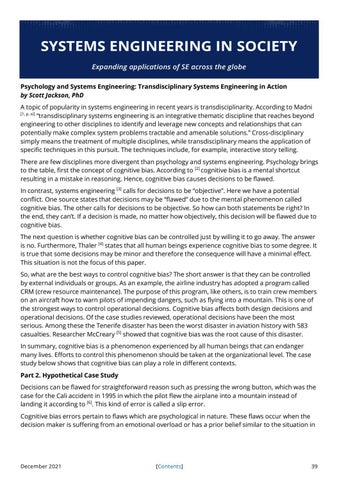SYSTEMS ENGINEERING IN SOCIETY Expanding application of SE across the globe
SYSTEMS ENGINEERING IN SOCIETY Expanding applications of SE across the globe
Psychology and Systems Engineering: Transdisciplinary Systems Engineering in Action by Scott Jackson, PhD A topic of popularity in systems engineering in recent years is transdisciplinarity. According to Madni [1, p. xi] “transdisciplinary systems engineering is an integrative thematic discipline that reaches beyond engineering to other disciplines to identify and leverage new concepts and relationships that can potentially make complex system problems tractable and amenable solutions.” Cross-disciplinary simply means the treatment of multiple disciplines, while transdisciplinary means the application of specific techniques in this pursuit. The techniques include, for example, interactive story telling. There are few disciplines more divergent than psychology and systems engineering. Psychology brings to the table, first the concept of cognitive bias. According to [2] cognitive bias is a mental shortcut resulting in a mistake in reasoning. Hence, cognitive bias causes decisions to be flawed. In contrast, systems engineering [3] calls for decisions to be “objective”. Here we have a potential conflict. One source states that decisions may be “flawed” due to the mental phenomenon called cognitive bias. The other calls for decisions to be objective. So how can both statements be right? In the end, they can’t. If a decision is made, no matter how objectively, this decision will be flawed due to cognitive bias. The next question is whether cognitive bias can be controlled just by willing it to go away. The answer is no. Furthermore, Thaler [4] states that all human beings experience cognitive bias to some degree. It is true that some decisions may be minor and therefore the consequence will have a minimal effect. This situation is not the focus of this paper. So, what are the best ways to control cognitive bias? The short answer is that they can be controlled by external individuals or groups. As an example, the airline industry has adopted a program called CRM (crew resource maintenance). The purpose of this program, like others, is to train crew members on an aircraft how to warn pilots of impending dangers, such as flying into a mountain. This is one of the strongest ways to control operational decisions. Cognitive bias affects both design decisions and operational decisions. Of the case studies reviewed, operational decisions have been the most serious. Among these the Tenerife disaster has been the worst disaster in aviation history with 583 casualties. Researcher McCreary [5] showed that cognitive bias was the root cause of this disaster. In summary, cognitive bias is a phenomenon experienced by all human beings that can endanger many lives. Efforts to control this phenomenon should be taken at the organizational level. The case study below shows that cognitive bias can play a role in different contexts. Part 2. Hypothetical Case Study Decisions can be flawed for straightforward reason such as pressing the wrong button, which was the case for the Cali accident in 1995 in which the pilot flew the airplane into a mountain instead of landing it according to [6]. This kind of error is called a slip error. Cognitive bias errors pertain to flaws which are psychological in nature. These flaws occur when the decision maker is suffering from an emotional overload or has a prior belief similar to the situation in
December 2021
[Contents]
39



